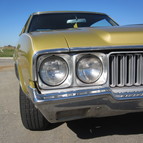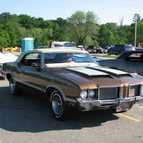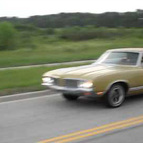
published | Tags: #Documents #Drive Test #SX
It's an awfully nice car to be the butt of bad jokes. The line's always delivered with a chuckle-chuckle and a toothy grin: "Hey, buddy, isn't the E missin'?" Whoever is in charge of letter designations for Oldsmobile performance and luxury automobile packaging ought to be ashamed of himself.
Indeed, SX does appear to lack an E, and it's unfortunate that Oldsmobile's new super-smoothie must suffer rude guffaws wherever it parks among gutterminds.
The Oldsmobile Cutlass SX is newest addition to the F-85 branch of this GM division family tree. Basically a notch-back Holiday Coupe, the SX is close relative of Cutlass, Cutlass Supreme, 4-4-2 and Vista Cruiser models. What distinguishes the SX from other members of the clan is a special set of performance parameters and the GM stylists' full "luxury" treatment inside and out.
Basic concept of the SX goes back to Oldsmobile's Turnpike Cruiser which appeared first in the 1967 model year. That one featured a 400 cu.-in. engine with a relatively small two-barrel carburetor and tall gearing for relaxed engine operation and excellent fuel economy in the 70-80 mph throughway speed bracket.
Oldsmobile's 455 cu.-in. loafer is part
of the SX package. Like the Turnpike Cruiser powerplant, the SX's 455 engine is twobarrel
carburetored. The 1.687-in. venturis of the 455's Rochester result in smooth fuel flow on
acceleration and miserly fuel consumption at cruise. The two-barrel carburetor means the
SX is no blown-off-atthe-stoplight, rumpa-rumpa drag racer. This induction system is for
swift, not quick. However, a 15.7-sec. is respectable enough.

Another element of the SX packet is a 2.56:1 rear axle ratio. The ratio range of 3.50:1 to 4.10:1 is for greenlight drag meets With the 2.56:1 ratio, the Cutlass SX slips along the freeway at well over 70 mph with the engine whispering at far fewer than 3000 rpm. Nice!
Conceivably, restricted intake, deliberate rather than brisk engine rpm rise on throttle application and the 2.56 cruise axle ratio could produce totally unacceptable acceleration. This definitely isn't the case with the Cutlass SX. The 455 and 2.56 axle are coupled together by a tightened-up torque converter Turbo -Hydra Matic threespeed automatic transmission. When the throttle is kicked in, the 1970 torque converter holds engine speed near top rpm, thus delivering peak torque for longer periods of time in gears than does the standard Olds torque converter. The effect is acceleration which, though not of quartermile competition variety, is completely adequate for freeway merging and passing.
The combination also results in fuel consumption in the 11-to 12-mpg bracket, which is remarkable in view of' overall piston displacement. The 455's 10.25:1 compression ratio 97 makes premium fuel mandatory, however, which offsets somewhat the mpg economy. A light foot could deliver 250 miles from the SX's 20-gal. fuel tank.
Another factor which contributes to the slick running ability of the SX is a set of Firestone belted G70-14 tires. The polyester and fiberglass belted tires offer far less rolling resistance than do old fashioned bias laid skins. One drawback to these particular tires is their behavior on wet pavement-instant unstick. (On clean, dry pavement, the Wide Ovals offer sufficient bite to hurl the SX around sonic fairly tight bends with a full measure of security. Water on the roadway almost completely negates this gripping capability and power slides can be induced almost at will. Whether tread pattern or compound or both are at fault could not be determined.
A good measure of the SX's ample cornering capability stems I from a truly well engineered suspension. Stability under cornering forces conics from a combination of springing that definitely is not spongy. shock damping rates that are firm, but slow, and an anti-roll bar that keeps everything flat.
The SX, with its distinct forward weight bias, tends to dive on braking, but the rebound from the dive is fairly well controlled, more of an ease-up than a snapback. The suspension handles abrupt bumps very well. However, on long, undulating dips at high speed, the slow shock damping sets the SX afloat on a porpoising jouncerebound cycle.

GM's disc/drum braking system, misproportioned from front to rear, was capable of really hauling down the SX's front end, which caused the light rear end to lift and slew noisily in one direction or the other. The left rear wheel locked up more frequently than the right wheel or both
On rain splattered pavement, the combination of almost 60/40 forward weight bias, truly efficient disc brakes, lack of proportioning between discs and rear drums, and the slippery Firestones produced some interesting little numbers, known in the trade as Brodies. This is kicks on damp dragways and skid pads, but much more exciting and hazardous on public roadways.
In, repeated hard braking on dry pavement, the pedal of the powerassisted system took on a wooden feel, but braking effectiveness remained almost constant.
As a small car with big engine, the SX is singularly docile, controllable and able to maintain high speeds for sustained periods. Parameters of SX performance are rapid transit, the eight-lane Interstate and smoothness.
This performance is packaged in what can only be termed unobtrusive wrappings. The basic Holiday Coupe lines are sleek, uncluttered and clean. In side view, the front fender line rises slightly above the front wheel cutout and swoops gently downward to rise again, peaking just ahead of the rear wheel cutout. The line drops easily once more to terminate in a forwardraked rear. The roofline echos this smooth sloping effect.
MOTORCADE's test Cutlass SX showed metallic bronze body paint below a black vinyl top-handsorne and certainly not blatant. An emblem here and there, a minimum of chronic trim, integral chronic bumpers and exposed headlamps lend to the overall understatement. But in the case of the SX, understate men t leans toward elegance.
If the SX exterior is spartan by luxury performance car standards, the inside of the SX is not. Toast brown plastic, simulated wood burl vinyl, rough grained leatherlike upholstery of similar material, beige carpeting and chromed plastic beading offer an admixture of tones and textures. In contrast to the subdued outside appearance of the car, the inside presents an overly busy look--too many things, too many pieces, too many shades, too many lines.
Over-ernphasized SX interior appointments may be, but the array does not detract from this Oldsmobile's creature comfort. A berich seat, divided by a fat, folding armrest is comfortable for driver and one or two passengers. Though smallest in the Olds line, F-85 Holiday Coupe seat adjustment tracks are so positioned as to afford ample front legroom for tall people. This is at the expense of greatly diminished Fear seat legroom, however.
Front headroom is minimal. Taller men
tend to find the tops of their heads against the liner The roofline of
the SX is to blame here.
This roofline, pleasing to the eye outside, requires a very low, steeply angled rear window. This, in turn requires very low positioning of the rear view mirror in the SX. The tall driver--whose head is pressed against the headliner--must duck down to peer under the wide mirror to assess what sort of traffic is coming at him on his right, or simply to observe a light change from red to green. The Cutlass SX is not alone among GM cars in this respect. Certain Buick, Pontiac and Chevrolet models, especially coupes, share this low rear view mirror and obscured vision syndrome.
Nitpicking aside, the excellence of the Cutlass emerges when the car is taken for a drive. On a cold morning, the SX starts easily, warms up quickly. In city street grid traffic, the SX displays impeccible manners, seeming to flow from stop to stop. Driving the SX through town is a pleasant twopedal reflex. The freeway on-ramp permits the 455 and torque converter to exercise themselves briefly as fastlane speed is achieved.
Then the SX settles into what it does best, the devouring of territory , the sucking up of concrete turnpike as if the car were a giant vacuum cleaner. At more than 80 mph a wind rumble develops, -but not sufficiently loud to interfere with conversation. A minor hood shake shows itself, but nothing else appears to say this car is easing toward 100. Braking down for the off-ramp is an effortless toe touch. A full stop is nothing more.
On the two-lane secondary road the SX stretches its legs once more, striding lightly over bumps and seams, hauling down quickly to round tight radius bends, then whispering up to speed again. Hills are nothing; the 455 eats hills for breakfast, mountains for lunch. A steep downgrade is accommodated easily by slipping into "Super "--second gear.
Back on the freeway and home again, it is difficult to realize that 200 miles or so have slid past in such a short space of time.
The roadway is the SX element. This second generation Turnpike Cruiser really belongs on turnpikes. It's a clean looking car with distinctive performance. Too bad the E is missing.
| TEST CAR: OLDSMOBILE CUTLASS SUPREME SX | Rear suspension: | Four-link trailing arms,coil springs, tubular shock absorbers. | |
| PRICE | |||
| Basic list, FOB | $ 3,151 | DIMENSIONS AND CAPACITIES | |
| As tested | $ 4,735 | Wheelbase, in. | 112,00 |
| Options included: | High compression 455 cu. in. engine, SX performance and trim packages, automatic transmission, power steering, power disc brakes, air conditioning, AM radio, rear speaker, tinted glass, special wheels, white stripe tires, firm ride shock absorbers, vinyl top. |
Track, F/R in. | 59.0/59.0 |
| Overall length, in. | 203,20 | ||
| Overall height, in. | 52,80 | ||
| Overall width, in. | 76,20 | ||
| Curb weight, lb. | 3910 | ||
| Weight distribution, F/R | 58.8/41.2 |
||
| Ground clearance, in. | 4,50 | ||
| Front seat hip room, in. | 59,70 | ||
| ENGINE | Shoulder room, in. | 58,30 | |
| Type | ohv V-8 | Head room in. | 38,20 |
| Bore x stroke, in. | 4.126 x 4.250 | Pedal-seatback, max. in. | 41,70 |
| C mpression ratio | 10.25:1 | Rear seat hip room, in. | 58,30 |
| Rated bhp @ rpm | 320 @ 4200 | Shoulder room, in. | 57,10 |
| Rated torque @ rpm | 500 @ 2400 | Leg room, in. | 34,10 |
| Induction system | 1 x 2 Rochester | Head room, in. | 36,40 |
| Electrical system | 12 V 61 amp hr | No- of passengers | 6 |
| Type fuel required | Premium | Luggage space, cu. ft. | 17 |
DRIVE TRAIN |
Crankcase, qt. | 5 | |
| Transmission type: | three-speed torque converter automatic | Cooling system, qt. | 17 |
| Clutch diameter | N/A | Fuel capacity, gal. | 20 |
Gear ratios: 1st |
2,48 | WHEELS AND TIRES |
|
2nd |
1,48 | Wheel size and type | 14 x 7 JJ |
| 3rd | 1,00 | Optional size | none |
| Shift [ever location | Steering column | Tire size and type G 70-14 | Firestone belted |
| Differential type | Semi-floating hypoid, limited slip | Normal inflation, F/R, psi | 24/24 |
Axle ratio |
2.56:1 |
Maximum load per tire | 1620 @ 32 |
| CHASSIS AND SUSPENSION | FUEL CONSUMPTION | ||
| Frame type | Perimeter with crossmembers | Test conditions, mpg | 11,10 |
| Brake type | 11 -in. disc fr./9.5-in. drum rear,power assisted | Normal conditions, mpg | 11,80 |
| Cruising range, mi. | 223-245 |
||
| Brake swept area, sq. in. | 345.6 | PERFORMANCE |
|
| Steering type | Variable ratio ball/nut, power assisted | Standing 1/4mile, sec. | 15,70 |
| Turns lock to lock | 3.3 | Speed at end, mph | 86,80 |
Turning circle, ft. |
43,30 |
Top speed, mph (est.) | 117 |
| Front suspension: | Unequal length A arms, coil springs, tubular shock absorbers, anti-sway bar. | Braking performance | Good |
| Directional control | Uncertain | ||
Related Post
 Latest Picture of My CarMy new desktop background from the weekend cruise. Can't really beat blue skies and a |
 Oldsmobile Tribute VideoA great video that shows a lot of great 442s and Cutlasses from the 1970 |
 1970 Cutlass SX Drive ByJust a casual drive by in my 1970 Cutlass SX (before exhaust). |